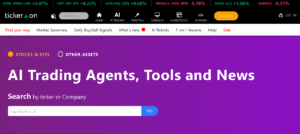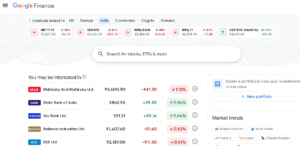Free AI Tools for Share Market
The share market (stock market) can seem scary. Lots of numbers, jargon, risk. But today, AI (Artificial Intelligence) tools are changing that. Even non-experts can use AI tools to understand stocks, make smarter decisions, and maybe improve outcomes. In this post, I’ll explain what AI tools are, why they help, and list several free ones you can start using right away.
What Is an Free AI Tools for Share Market ?
An Free AI Tools for Share Market uses smart computer algorithms (machine learning, pattern recognition, etc.) to analyse stock market data. It can do things like:
Predict trends: will a stock go up or down?
Spot patterns: are there repeating events that may signal opportunity?
Summarise news: what are people saying about a company that might move the stock?
Give signals: maybe it alerts when a stock looks “cheap” or “overbought.”
The benefit is: can process much more data than humans can, and faster. But it’s not magic—it doesn’t always get things right. You always need to use them carefully.
Why Use Free AI Tools for Share Market ?
If you’re new, or don’t want to spend money:
Low risk: no big cost to try.
Learn what works: you see how predictions are made, which methods are helpful.
Supplement your analysis: even if you use paid tools later, free ones give you extra viewpoint.
Top Free AI Tools for Share Market
Here are some usable, free-or partly-free tools. I’ve included what they do, and what to watch out for.
Tool What It Does Good for Beginners What to Watch Out For

Offers pattern matching, forecasts, stock-signal alerts. You can see charts and predictions. Good because interface is fairly simple; you don’t need coding skills. Free tier may have delays, limited stocks; deeper predictions often in paid version.
Compares stocks, gives indicators like momentum, trend, gives AI-based suggestions. Helps you see side by side which stocks look “better” based on AI signals. The “AI suggestions” are just probabilities; rare to be 100%. Always check yourself.

Free AI Tools for Share Market- Spiking Tracks
big investor/institution trades; shows alerts when famous investors make moves. Good for following what the “smart money” is doing; sometimes big moves by big investors give hints. Data may lag; big investors don’t always tell full story; sometimes they move for reasons you can’t see.

Technical indicators, charts, some forecasting tools; backtesting simple ideas. If you have a trading idea, you can test it historically (how it would have done in past years). Past performance future result. Also, free data historically can have gaps.
FinRL (open source) Build your own AI trading strategies; try reinforcement learning, test them on historical data. If you are okay with a little coding (Python etc.), this gives great learning. Setup can be complex; needs computer, time; outcome highly sensitive to data & parameters.
Free AI Tools Especially Useful in India (for NSE / BSE)
Because many free tools are global (USA, Europe), they may not always cover Indian stocks well. Here are a few that either cover or can be adapted for the Indian market, or free resources you can build upon:
Yahoo Finance / Google Finance – for basic stock price data, company info, charts.

Alpha Vantage (free tier) – API for historical & current price data. You can fetch data for Indian stocks (if supported) and use it in your own tool or Excel.

Kaggle – data-sets about Indian stock markets; you can experiment building small models.
Local financial news sites/apps (e.g. Moneycontrol, Economic Times) – while not “AI tools”, they provide important inputs for sentiment, which you can combine with AI signal tools.
How to Use These Free AI Tools for Share Market (Step by Step)
Here’s a simple plan anyone could follow to make use of Free AI Tools for Share Market
- Pick a few tools: maybe one “prediction” tool, one chart / technical tool, one news / sentiment tool.
- Watch a stock: select 2-3 stocks you are curious about. Use the AI tools to see what they say (trend up/down, news, what big investors are doing).
- Compare outputs: maybe one tool says “strong uptrend”, another says “overbought”, another says “news is bad”. Look at all. Don’t trust just one.
- Backtest simple ideas: if tool offers historical data, see if your idea would have worked in past years. For example: “Buy when this AI signal crosses threshold, sell after 5 days” – how would that have done?
- Paper-trade first: (simulate trading without real money) or use small money to test. Learn from wins and losses.
- Refine with experience: you’ll learn which tools/signals align with your style (long term vs short term, risk level etc.).
Tips to Get Better Results for Free AI Tools for Share Market
Check current news: AI tools might lag non-algorithmic events (e.g. new regulations, sudden political news). Always check what is happening.
Diversify: don’t focus only on one sector or one stock; spread risk.
Set stop-loss / limits: even with AI signals, market can drop—protect yourself.
Use multiple tools: if two or three independent tools agree, that might increase confidence.
Keep learning: over time, you’ll understand which tools / signals work for your style.
Frequently Asked Questions (FAQs) for Free AI Tools for Share Market
Q1: Can I trust AI tools totally?
No. They are aids, not guarantees. Think of them like hints or helpers. Always use your judgment.
Q2: Do free tools work for intraday trading?
Some may help, but free tools often have delays or lower accuracy for very short-term trades. For intraday you may need faster data (paid).
Q3: Is coding required?
Not always. Many free tools have ready-made dashboards. But using APIs or tools like FinRL will require some coding skills (Python etc.).
Q4: Can AI tools predict crashes or big losses?
They try , but often fail to fully predict unexpected events. Use risk management, don’t bet everything on predictions.
Free AI Tools for Share Market can be very helpful, especially if you’re starting out. They give you insights, help you see patterns, and reduce guesswork. But they’re not perfect. The smartest way is to use them as helpers, not oracles. Combine tool outputs with your own research, keep risk low, and gradually build your understanding.
If you start with one or two tools, test them on a few stocks, compare results, and learn—before committing large capital—you’ll be much safer.

